Keeper Kebari
The Keeper Kebari is a modification of a fly I tied for the Tying Tenkara Flies DVD. I had called that fly the Sakakibara Kebari, after Masami Sakakibara (Tenkara no Oni) who is known for tying and fishing flies up to size 2. For the DVD, I couldn't bring myself to buy size 2 hooks. I used a size 6 nymph hook, which still looks awfully large compared to a normal kebari. The Keeper Kebari has a substantially thicker body than the fly I tied on the DVD, and I've added a copper wire rib.
Although initially tied for the DVD in 2011, for a long time I hadn't really given the fly a fair workout - it really did seem to be too large. I finally tried it for smallmouth bass on a trip to Maine in 2013 and I was shocked at how effective it was. With other flies, I would often see bass come up out of the depths, take a close look at a fly or even bump it and then go back down. This fly they just took without hesitation.
When I got back home to New York, I tried it for trout in one of my usual streams and I was shocked again. Surprisingly often, fish took the fly as soon as it hit the water's surface. I'd had that happen before, but only occasionally. On this particular day, it was not at all uncommon. That was it, the fly became a "keeper" and the name got changed.
The fly is tied on a Size 6 Daiichi 1560 nymph hook, with black Uni-Thread, a hen pheasant breast feather, Jamieson's Shetland Spindrift "Oxford" yarn (any black or dark gray wool yarn will do) and a copper wire rib.
If you'd rather buy than tie, even though I no longer sell flies, "Kiwi" Kuhlow, who tied all the flies I sold in later years, still does. Send an email to the Contact Us page and I will put you in touch with him.
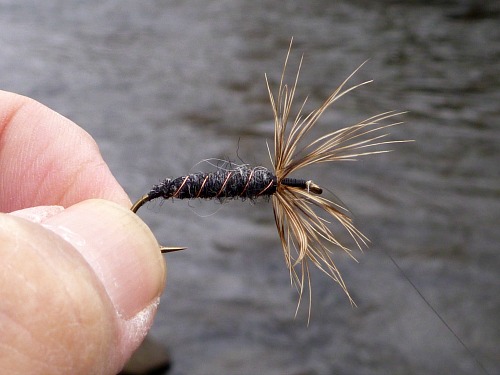
Keeper Kebari Step by Step
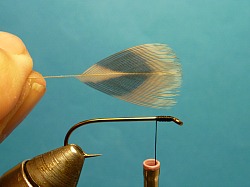
1. Start the thread at the eye, and do about ten wraps back toward the bend. To make the head thicker, do three layers of wraps.
Strip a hen pheasant breast feather so that the length of what is left is about the same length as the hook shank.
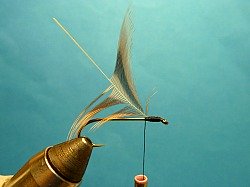
2. Tie in the feather by the tip, with the concave side of the feather facing toward you. Clip the excess. Wrap the thread to the eye and back to the feather. Do three wraps on the hook shank beyond the feather, which helps the feather stand up and helps to get the thread out of the way.
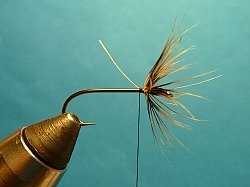
3. Wrap the feather with the concave side facing the hook eye, each successive wrap behind the previous wrap, stroking the barbs out of the way for each wrap. If you wrap the hackle carefully, keeping the concave side facing forward, you'll get the perfect sakasa shape automatically. You should not have to force it with thread wraps, which usually gives you hackle that is slanted much too far forward. The forward slant is subtle, not dramatic.
If you stripped the feather to the right length, you should get to bare stem in four wraps. Getting the length of the stripped feather right allows you to tie off cleanly without tying down barbs that would then need to be trimmed off. In the photo above no barbs had to be cut off. Tie off and then cut the feather stem.
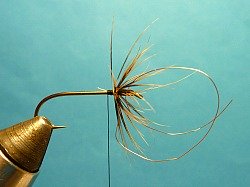
4. Tie in about 4" of copper wire, then coil the wire so it will be out of the way when you wrap the yarn.
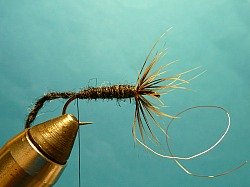
5. Start the yarn as you would thread, just behind the hackle. Wrap to the bend, clipping the tag end when you are 1/3 to 1/2 way back.
As you wrap the yarn, it will push the thread ahead of it. Wrap to the bend, back to the hackle and once again back to the bend. The body taper is formed by differing tension on the yarn, less toward the hackle and more towards the bend. It will also help if you wrap so that on the rear half of the hook shank the two strands of the yarn lay side by side.
When you get to the bend, tie off the yarn with three thread wraps. Clip the excess.
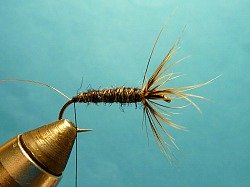
6. Wrap the wire to the bend in the opposite direction as the yarn (it would be counter clockwise if the hook eye was pointing towards you). Tie off at the bend.
Do a 5 turn whip finish (touching turns toward the eye) to form a thread tag. Clip the thread and break off the wire.
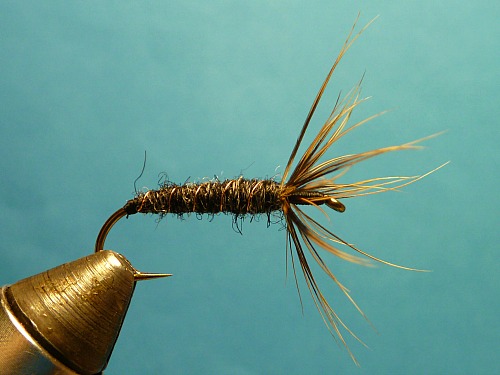
A kebari tied on a size 6 Daiichi 1560 nymph hook is not too small for bass and not too large for trout. There aren't bluegills in Maine, but the redbreast and pumpkinseed sunfish took them easily (and readily). I am confident that bluegills will as well.
After posting the step-by-step for the Keeper Kebari I realized that most people don't have pheasant skins. The same fly can be tied with partridge if you use the larger feathers on the flank.
I have also tried the fly with
the browner Jamieson's Shetland Spindrift Moorit/Shaela yarn, as has one of my customers (see Brad C's note above and to
the right). The Black Killer Bugger yarn seems to work better.
Tied with Moorit/Shaela yarn and a partridge feather, the resulting fly looks like this dry (although this fly has a slightly shorter, fatter body and was tied before I decided the fly needed a wire rib to hold the yarn in place):
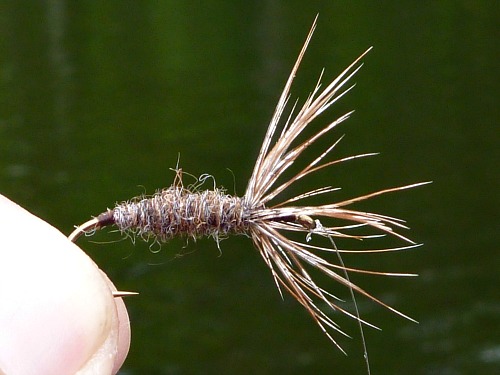
It looks like this wet:
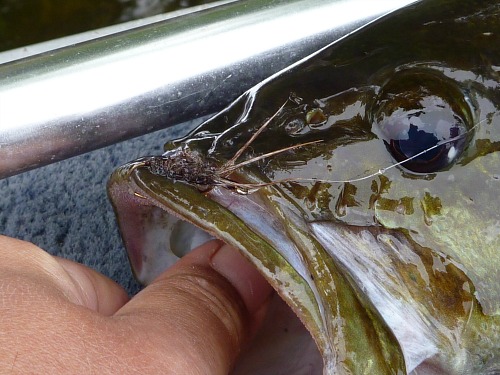
What was most surprising for me is how confidently both smallies and trout took the Keeper Kebari. I have hooked carp with this fly, but have not yet landed one while using it.
I'm not sure what this fly triggers in fish, but it does trigger something. So far, this has been an extremely effective fly.
Definitely a keeper.
TenkaraBum Home > Tenkara Flies > Keeper Kebari
“The bitterness of poor quality remains long after the sweetness of low price is forgotten” - Benjamin Franklin
"Be sure in casting, that your fly fall first into the water, for if the line fall first, it scares or frightens the fish..." -
Col. Robert Venables 1662
As age slows my pace, I will become more like the heron.
Warning:
The hooks are sharp.
The coffee's hot.
The fish are slippery when wet.
Beware of the Dogma
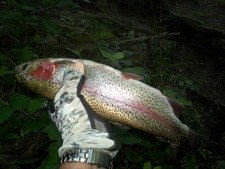
This was one of three the same size caught on a No. 6 Big Black Kebari (Oxford and hen pheasant) on the Swift River in Massachusetts this a.m. Interestingly, right after I caught the third one I lost the fly and tied on a similar Big Brown Kebari with the Moorit-Shaela yarn and Partridge but got nothing then I put another Big Black Kebari on and quickly missed a strike and dropped another.
In addition to these and five trout, none of which made it to my net on the East Branch of the Westfield, I have also caught on the Big Black No. 6 Kebari;
Large Mouth;
Small Mouth;
Blue Gill;
Crappie;
Pickerel;
White Perch; and
Yellow Perch.
The fly is possibly a real contender for a single fly.
Brad C, Massachusetts
I've only been fishing once so far for about two hours. So far I've only used one fly, the Keeper Kabari (Moorit yarn). It's catching fish! It's definitely a keeper! And I'm enjoying the rod [Daiwa Kiyose 43M]!
I've netted 3 cutthroats so far, with one being probably the largest cut I've ever caught. I saw him occassionaly hitting very tiny flies near the surface about 25 feet below me. I just took my time and slowly fished in his direction. He snapped up the fly as it straightened the line and began its swing. Thanks again.
Jed J, Montana
I’ve meant to say thanks for the keeper kebari directions on your site - it was the first fly I tied and the first fly I tied that I caught a fish with. My friends regularly say after so many catches, “what have you got on there?!?”
John H, Washington
Love this fly.
Jim P, Pennsylvnia


